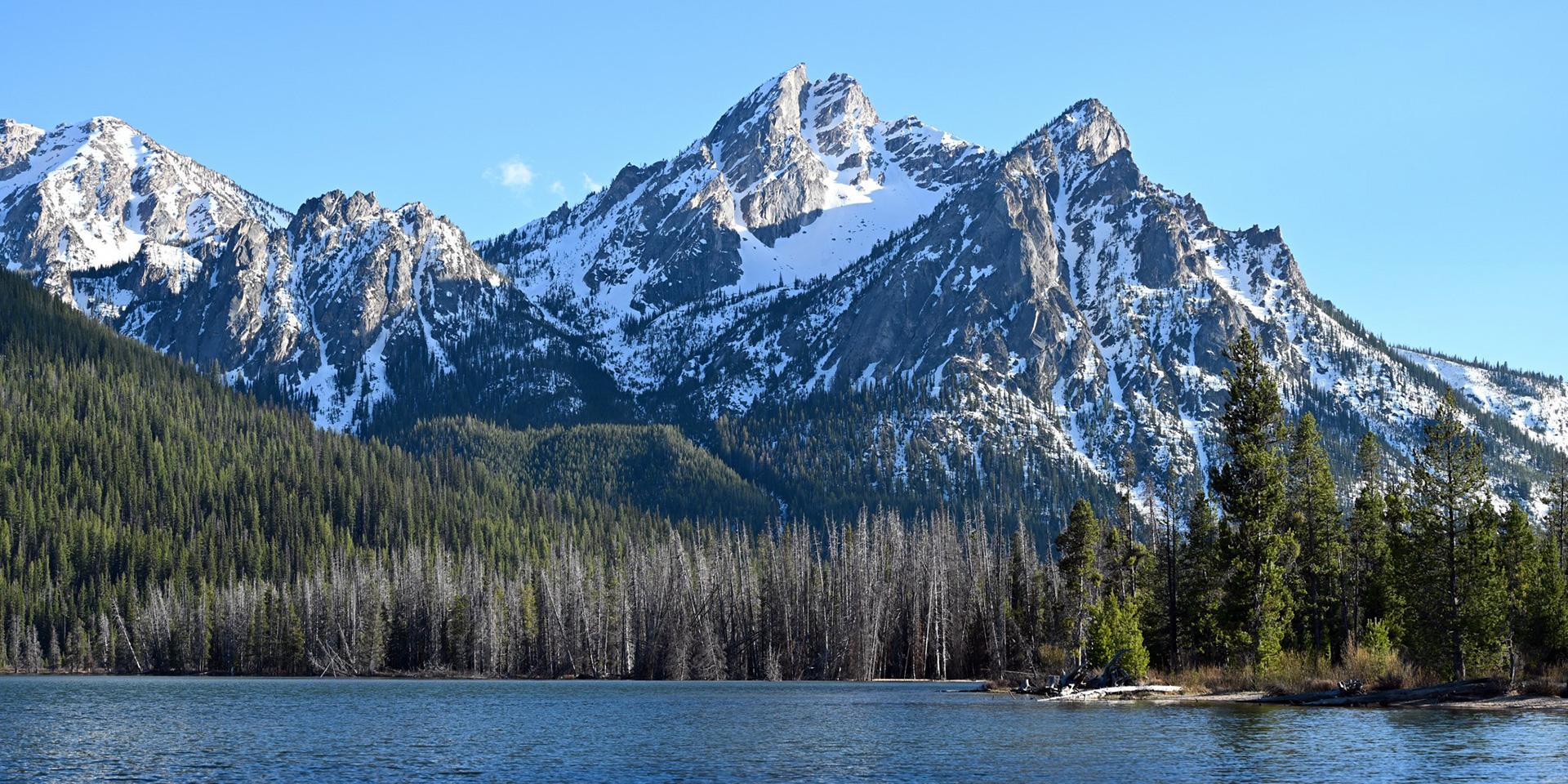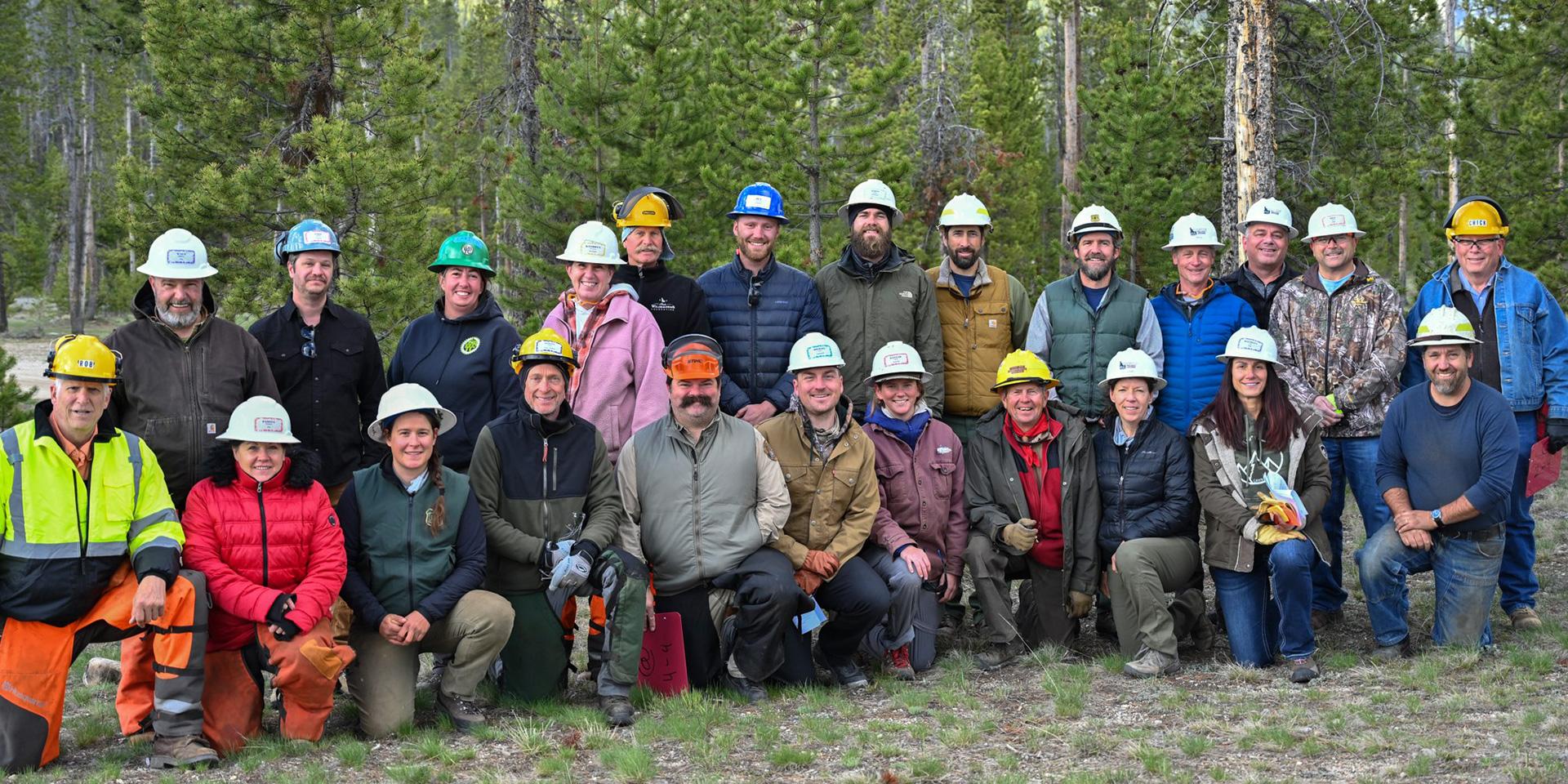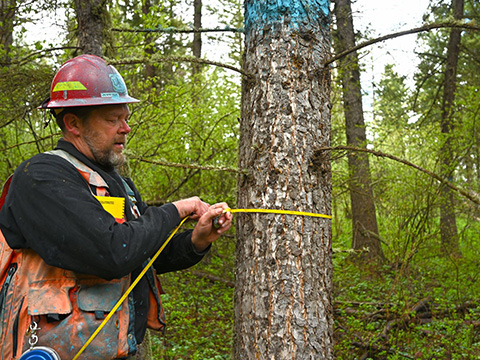The Stanley Workshop located in Stanley, Idaho in the Sawtooth National Recreation Area is an example of a partner-led training within the Saw Program. It is an opportunity for new sawyers from partner organizations to become certified in both crosscut and chainsaw, and for existing sawyers to get recertified to maintain their qualifications. (USDA Forest Service video by Sabrina Kohrt)
A rip of a chainsaw and slice of a thin metal blade wedged through a tree interrupted the crisp and quiet bluebird morning, a mile from the striking Stanley Lake in the Sawtooth National Recreation Area.
Sawyers in training, dressed in hardhats, gloves, ear plugs, chaps, and eye protection, began to receive direction from instructors. There was a buzz of nervous energy from those who had never picked up a saw. The Stanley Workshop had begun.
The Stanley Workshop
The United States Department of Agriculture’s Forest Service Saw Program works closely with partners to certify “sawyers,” which are those authorized to operate a saw on National Forest System lands. Regardless of organization, all sawyers must complete appropriate training and can do so through either the Forest Service or partner groups.
Certified sawyers are needed across all major areas of land management, especially for maintaining trails for recreational use and clearing hazardous trees for wildland fire and fire prevention. Sawyers are in high demand in the spring and summer when snowpack melts to reveal downed trees and forest litter that restrict trail access.
Building capacity
Through agreements, partners receive training from the Forest Service and then train sawyers within their own organization. As more sawyers become certified, capacity increases, which results in greater clearing and maintenance of trails - keeping them open for public use. The Saw Program relies heavily on its partners for this reason. This collaboration largely supports the volume of trail work needed on national forests.
“Nationally, we have over 150,000 miles of trail on national forest lands and last year over half of the trails that were maintained were done by volunteers and partner organizations,” said Brian Burbridge, the Intermountain Region Forest Service Saw Program Manager in Ogden, Utah. “Keeping access points open to the public is huge so they can go and be connected to the forests.”
The sawyer community
“People tend to be passionate about sawyering, good saw technique and the history of saws,” said Greg Travelstead, Pulaski Users Group Board President. “It’s a community that naturally mentors, naturally wants people to become more engaged.”
Within the Intermountain Region, which includes Utah, Nevada, and parts of Idaho and Wyoming, the Saw Program engages with over 40 partners and organizations, all working with the Forest Service Saw Program to provide training for new sawyers, as well as evaluations, recertification, and safety education. These groups are made up of nonprofits, cooperators, and volunteer organizations, including Backcountry Horsemen, Pulaski Users Group, Sawtooth Society, Student Conservation Association, Great Basin Institute, American Conservation Experience, Friends of Nevada Wilderness, and more.
“I don’t really feel very much difference between whose agency, whose partner group,” said Travelstead. “We’re sawyers all trying to steward public land together.”
By design, the program focuses on collaboration with partners, co-teaching, knowledge sharing across boundaries, and sawyer-to-sawyer mentorship.
This community, with more than 25,000 sawyers in the program across the country, cultivates an inclusive environment that focuses on caring for the land together despite organizational lines.
“The community, to me, feels like an equitable, shared collaboration with all these groups. We are sharing opportunities for training, sharing opportunities for learning, whether it is near misses or lessons learned. I think it is truly a collaborative effort to move the program forward. It is not just one agency or organization driving it,” said Burbridge.
The art of saws
Known to be loud, powerful, and quick, chainsaws are one of the most common tools used to cut trees on National Forest System lands. The two-stroke gas-powered engine is widely used, although the industry has also quickly adopted electric chainsaws. Chainsaws are the benchmark of efficiency; its pure horsepower can slice through large diameter trees in mere minutes. Chainsaws can be used for bucking, the process of cutting a fallen tree into smaller sections, and felling, which is cutting down a standing tree.
Conversely, the crosscut saw is a non-motorized saw, typically a handle on each end for two sawyers to alternate pulling the saw through the wood. These saws come in a variety of lengths from three to eight feet, with different tooth patterns and can be used for both bucking and felling operations. Many of these saws are antiques and sought out by crosscut sawyers. There are not many people in the nation who still sharpen crosscut saws, which is hand done using a variety of files and gauges that have been used for more than a century. Sharpening a crosscut saw is an extremely meticulous process with zero margin for error. Crosscut saws are primarily used in designated wilderness areas, per the Wilderness Act of 1964, which directs that there shall be no use of motorized equipment in these areas.
Becoming a sawyer
A sawyer can obtain three different levels of certification for either crosscut, chainsaw, or both. There are also ‘bucking only’ certifications that are recognized for sawyers who do not need to fell trees as part of their job. To get certified, sawyers must complete a multiday course that includes both classroom and field training.
An A-level sawyer is considered an apprentice and can perform low complexity cuts under supervision of a B or C sawyer. Most sawyers enter the Forest Service saw program as an A-sawyer and will continue building skills with saws for a year or two before moving to a B-Certification. The majority of sawyers across National Forest System lands are at the B-level, where they can assist A sawyers and cut unsupervised within some moderately complex situations. Some of the more experienced B sawyers can provide formal instruction and evaluate sawyers at the A-level with approval.
A C-level sawyer may operate a saw in highly complex situations including fire-weakened timber, storm damage, large diameter trees, rotten or compromised wood fibers, or loose hanging material in a tree. Other elements include steepness of slope, tree stand condition, wind, and human factors including a sawyer’s ability to walk away from a dangerous situation if it exceeds their skill level. C-level sawyers also have the responsibility of training and evaluating other sawyers.
It is very difficult to become a C-level sawyer, as it can take anywhere from seven to ten years to get this certification. With every tree a sawyer cuts throughout their career something is learned, at the C level the experience of many years of woodswork is paramount to operations. Regardless of level, all sawyers must recertify every three years and be current in First Aid and CPR training.
Shared vision
Collaboration with partners is not only vital to the success of the Saw Program, but also in meeting agency goals, which includes delivering benefits to the public. Sawyers in the program are critical agents of land stewardship, helping keep trails open for the public to recreate safely and responsibly.
“Our partner organizations are just as involved or represented as a forest would be and that is the way they are viewed,” Burbridge said. “I think it really allows them to be part of the vision of the organization, to be part of the vision of the program.”
Burbridge adds, “It gives them ownership in the work that they do and connects them with others that are doing similar things that are in the same training capacity… They are valued just as much as a forest employee would be.”
To learn more, visit: The Forest Service Saw Program, Sawtooth National Recreation Area, or Forest Service Partnerships.










